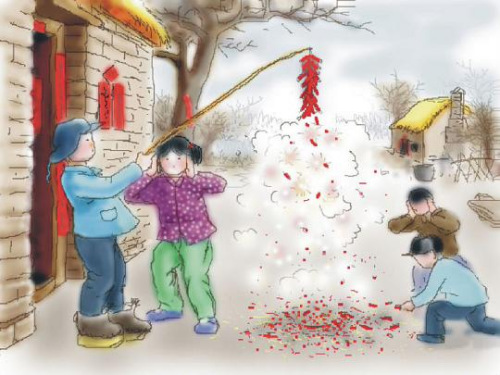
(File Photo)
The Spring Festival is most magnificent and most important festival with the greatest cultural connotation in China. There are many traditional customs during Spring Festival such as setting off firecrackers, lighting bonfires, hanging lanterns, and eating dumplings, all of which reveal the way of thinking and history of the ancient Chinese people as well as the traditional Chinese culture and philosophy.
Compliance with nature's laws
Spring Festival usually comes shortly before or after one of the twenty four solar terms called the "Beginning of Spring". It marks the beginning of the four seasons in a year as well as a time of renewal and nature's resurrection.
According to traditional Chinese calendar, the Spring Festival is truly the beginning of the New Year and new season not only in terms of timing but also in terms of climate. Yin-Yang opposition is an important aspect ancient Chinese people's thinking.
During the Spring Festival, many fire-related matters have something to do with this concept of adjustment between Yin and Yang. For example, every household will light torches and bonfires in their courtyards in Lunar New Year's Eve to pray for prosperity; and they will all ignite the "ever-burning light" not to be blown out throughout the night, as a way to pray for longevity and well-being. Burning firecrackers is a tradition followed to "ring out the old year and ring in the new". Initially it was also a sun-worship act but later it gained the connotation of driving out evil and fouling spirits as well as welcoming good gods.
Finding balance
Most traditional Chinese festivals are celebrated with special dishes which reveal the way of thinking of ancient Chinese trying to find balance. In the eyes of ancient Chinese people, each food is produced with two kinds of substances respectively attributed with Yin and Yang properties.
Foods eaten in different seasons symbolize harmony in their own ways. Only by sacrificing foods consistent of Yin and Yang properties, the ritual will bring harmony between man and nature; and only by eating foods symbolizing a balance between Yin and Yang, people will enjoy peace and prosperity.
The symbolic dishes during the Spring Festival such as dumplings, rice cakes, and rice glue balls all represent the combination of Yin and Yang. For example, a dumpling is the combination of pasta, which has Yin properties, and the stuffing, which has Yang properties. The exterior appearance of a dumpling is like the crescent moon, while the stuffing inside is round and symbolizes the sun. Their combination symbolizes the conjunction of Yin and Yang.
Pursuit of harmony
The Spring Festival represents the beginning of a new lunar year. Most Chinese people hold memorial ceremonies to warship gods and ancestors, praying for peace, prosperity and good luck in the coming year. These rituals and praying activities can be seen as the ancient Chinese people's philosophy of pursuing harmony.
Praying activities during the Spring Festival imply the ternary-structured way of thinking. Usually before the Lunar New Year's Eve dinner, the family must first hold a memorial ceremony to warship ancestors. Sacrifices are placed in front of the ancestral shrine, usually the heads of three animals such as a goat, cow and a pig.
Three bowls of cooked rice, three cups of wine, and three cups of tea must be offered and three sticks of incense will be burned during the ritual. All family members bow down three times or kowtow three times while bowing nine times. Customs associated with "three" are very common in various ethnic groups.
Such praying activities associated with "three" during the Spring Festival ritual New Year ritual, represent the ternary-structure way of thinking, which is an important part of ancient Chinese people's philosophy when it comes to pray for the harmony and unity of heaven, earth, and man, in order to find balance between heaven and earth, the human society, and all individual, but also a way so that all gods from heaven and earth will protect the country, the society, families, and individuals with good luck, happiness and good health.
The praying activities in Spring Festival rituals also imply the quinary-structure way of thinking. In ancient times, it was a tradition to welcome the gods that descended from five directions, the God of Wealth, the God of Blessings, the God of Nobleness, the God of Delight, and the Tai Sui God. In many parts of China, the tradition is still alive.
Generally, the household should open all doors and windows at midnight on the fifth of January according to Chinese lunar calendar while lighting incense sticks and setting off firecracker to welcome the five gods who will bring fortune.
All of these traditions are associated with the quinary-structure way of thinking which is based on the theory of the five elements. In this theory it is believed that the world is material and the universe is made by five basic elements (wood, fire, metal, water, and soil).
All substances in the universe can be classified in accordance with the five basic material properties. The theory is very complex but mainly believes that that the five elements counteract with one another and coexist in harmony.
Both individuals and the society must rely on the mutual balance among the five elements to maintain a state of harmony. The absence of any of these elements will result in crisis or instability.
As can be seen from these traditions and ways of thinking, Chinese Spring Festival has very colorful cultural connotations. We should cherish the wisdom of our ancestors and consciously protect and promote the Spring Festival culture.

Copyright ©1999-2011 Chinanews.com. All rights reserved.
Reproduction in whole or in part without permission is prohibited.